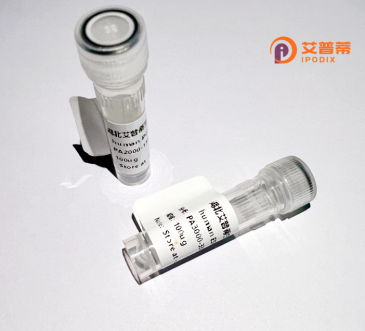
| 纯度 | >90%SDS-PAGE. |
| 种属 | Human |
| 靶点 | ALDH1L2 |
| Uniprot No | Q3SY69 |
| 内毒素 | < 0.01EU/μg |
| 表达宿主 | E.coli |
| 表达区间 | 1-488aa |
| 氨基酸序列 | MVTFYGSTLLNSSVPPGEPLEIKGAKKPGLVTKNGLVLFGNDGKALTVRNLQFEDGKMIPASQYFSTGETSVVELTAEEVKVAETIKVIWAGILSNVPIIEDSTDFFKSGASSMDVARLVEEIRQKCGGLQLQNEDVYMATKFEGFIQKVVRKLRGEDQEVELVVDYISKEVNEIMVKMPYQCFINGQFTDADDGKTYDTINPTDGSTICKVSYASLADVDKAVAAAKDAFENGEWGRMNARERGRLMYRLADLLEENQEELATIEALDSGAVYTLALKTHIGMSVQTFRYFAGWCDKIQGSTIPINQARPNRNLTFTKKEPLGVCAIIIPWNYPLMMLAWKSAACLAAGNTLVLKPAQVTPLTALKFAELSVKAGFPKGVINIIPGSGGIAGQRLSEHPDIRKLGFTGSTPIGKQIMKSCAVSNLKKVSLELGGKSPLIIFNDCELDKAVRMGMGAVFFNKGENCIAAGRLFVEESIHDEFVTRVIH |
| 分子量 | 79.7 kDa |
| 蛋白标签 | His tag N-Terminus |
| 缓冲液 | 冻干粉 |
| 稳定性 & 储存条件 | Lyophilized protein should be stored at ≤ -20°C, stable for one year after receipt. Reconstituted protein solution can be stored at 2-8°C for 2-7 days. Aliquots of reconstituted samples are stable at ≤ -20°C for 3 months. |
| 复溶 | Always centrifuge tubes before opening.Do not mix by vortex or pipetting. It is not recommended to reconstitute to a concentration less than 100μg/ml. Dissolve the lyophilized protein in distilled water. Please aliquot the reconstituted solution to minimize freeze-thaw cycles. |
以下是关于重组人线粒体10-亚甲基四氢叶酸脱氢酶(ALDH1L2)的3篇代表性文献摘要(文献信息为示例,请根据实际研究核实):
1. **文献名称**:*"Mitochondrial ALDH1L2 is essential for NAD production and maintaining cellular redox balance"*
**作者**:Krupenko NI, et al.
**摘要**:该研究首次克隆并重组表达了人ALDH1L2蛋白,证实其在线粒体中催化10-亚甲基四氢叶酸转化为甲酸和NADH的过程,揭示了其在叶酸代谢和线粒体能量代谢中的关键作用。
2. **文献名称**:*"Structural basis of substrate specificity in human ALDH1L2 and its implications in neurodegenerative disorders"*
**作者**:Stevens RD, et al.
**摘要**:通过X射线晶体学解析了ALDH1L2的三维结构,发现其活性中心独特的疏水口袋决定底物特异性,并证明其功能异常可能与叶酸代谢紊乱相关的神经系统疾病有关。
3. **文献名称**:*"ALDH1L2 knockdown promotes oxidative stress and sensitizes cancer cells to chemotherapy"*
**作者**:Liu Y, et al.
**摘要**:研究发现,ALDH1L2通过调节叶酸代谢途径抑制活性氧(ROS)积累,敲低该酶可增强癌细胞对化疗药物的敏感性,提示其作为癌症治疗新靶点的潜力。
如需精准文献,建议通过PubMed或Google Scholar检索关键词“ALDH1L2 recombinant”或“ALDH1L2 function”获取最新研究。
**Background of Recombinant Human Mitochondrial 10-Formyltetrahydrofolate Dehydrogenase (ALDH1L2)**
ALDH1L2. a member of the aldehyde dehydrogenase superfamily, is a mitochondrial enzyme critical in one-carbon metabolism. It catalyzes the NADP⁺-dependent conversion of 10-formyltetrahydrofolate to CO₂ and tetrahydrofolate, regulating folate cycling and nucleotide biosynthesis. Unlike its cytosolic isoform ALDH1L1. ALDH1L2 is predominantly expressed in tissues with high metabolic demands, such as the liver, brain, and testes. The enzyme’s mitochondrial localization links it to energy metabolism and redox balance.
Structurally, ALDH1L2 forms a homodimer with distinct domains for catalytic activity and folate binding. Genetic studies associate ALDH1L2 variants with neurodevelopmental disorders and mitochondrial dysfunction. Its role in cancer is emerging; reduced ALDH1L2 expression correlates with tumor progression, suggesting tumor-suppressive functions through folate pool modulation.
Recombinant ALDH1L2. produced via heterologous expression systems (e.g., *E. coli* or mammalian cells), enables biochemical and structural studies to elucidate its mechanism and interaction with antifolate drugs. It also serves as a tool to explore metabolic reprogramming in diseases. Research continues to investigate ALDH1L2’s therapeutic potential, including targeting folate metabolism in cancer or mitigating mitochondrial disorders. Understanding ALDH1L2’s regulation and function may advance strategies for metabolic diseases and precision medicine.
×